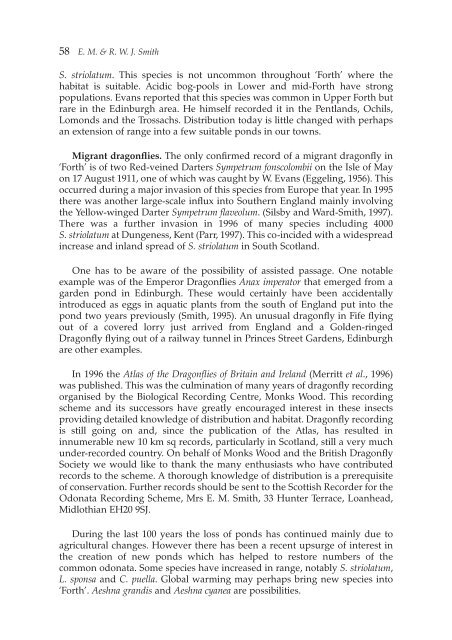the Forth Naturalist Historian - Forth Naturalist and Historian ...
the Forth Naturalist Historian - Forth Naturalist and Historian ...
the Forth Naturalist Historian - Forth Naturalist and Historian ...
Create successful ePaper yourself
Turn your PDF publications into a flip-book with our unique Google optimized e-Paper software.
58 E. M. & R. W. J. Smith<br />
S. striolatum. This species is not uncommon throughout ‘<strong>Forth</strong>’ where <strong>the</strong><br />
habitat is suitable. Acidic bog-pools in Lower <strong>and</strong> mid-<strong>Forth</strong> have strong<br />
populations. Evans reported that this species was common in Upper <strong>Forth</strong> but<br />
rare in <strong>the</strong> Edinburgh area. He himself recorded it in <strong>the</strong> Pentl<strong>and</strong>s, Ochils,<br />
Lomonds <strong>and</strong> <strong>the</strong> Trossachs. Distribution today is little changed with perhaps<br />
an extension of range into a few suitable ponds in our towns.<br />
Migrant dragonflies. The only confirmed record of a migrant dragonfly in<br />
‘<strong>Forth</strong>’ is of two Red-veined Darters Sympetrum fonscolombii on <strong>the</strong> Isle of May<br />
on 17 August 1911, one of which was caught by W. Evans (Eggeling, 1956). This<br />
occurred during a major invasion of this species from Europe that year. In 1995<br />
<strong>the</strong>re was ano<strong>the</strong>r large-scale influx into Sou<strong>the</strong>rn Engl<strong>and</strong> mainly involving<br />
<strong>the</strong> Yellow-winged Darter Sympetrum flaveolum. (Silsby <strong>and</strong> Ward-Smith, 1997).<br />
There was a fur<strong>the</strong>r invasion in 1996 of many species including 4000<br />
S. striolatum at Dungeness, Kent (Parr, 1997). This co-incided with a widespread<br />
increase <strong>and</strong> inl<strong>and</strong> spread of S. striolatum in South Scotl<strong>and</strong>.<br />
One has to be aware of <strong>the</strong> possibility of assisted passage. One notable<br />
example was of <strong>the</strong> Emperor Dragonflies Anax imperator that emerged from a<br />
garden pond in Edinburgh. These would certainly have been accidentally<br />
introduced as eggs in aquatic plants from <strong>the</strong> south of Engl<strong>and</strong> put into <strong>the</strong><br />
pond two years previously (Smith, 1995). An unusual dragonfly in Fife flying<br />
out of a covered lorry just arrived from Engl<strong>and</strong> <strong>and</strong> a Golden-ringed<br />
Dragonfly flying out of a railway tunnel in Princes Street Gardens, Edinburgh<br />
are o<strong>the</strong>r examples.<br />
In 1996 <strong>the</strong> Atlas of <strong>the</strong> Dragonflies of Britain <strong>and</strong> Irel<strong>and</strong> (Merritt et al., 1996)<br />
was published. This was <strong>the</strong> culmination of many years of dragonfly recording<br />
organised by <strong>the</strong> Biological Recording Centre, Monks Wood. This recording<br />
scheme <strong>and</strong> its successors have greatly encouraged interest in <strong>the</strong>se insects<br />
providing detailed knowledge of distribution <strong>and</strong> habitat. Dragonfly recording<br />
is still going on <strong>and</strong>, since <strong>the</strong> publication of <strong>the</strong> Atlas, has resulted in<br />
innumerable new 10 km sq records, particularly in Scotl<strong>and</strong>, still a very much<br />
under-recorded country. On behalf of Monks Wood <strong>and</strong> <strong>the</strong> British Dragonfly<br />
Society we would like to thank <strong>the</strong> many enthusiasts who have contributed<br />
records to <strong>the</strong> scheme. A thorough knowledge of distribution is a prerequisite<br />
of conservation. Fur<strong>the</strong>r records should be sent to <strong>the</strong> Scottish Recorder for <strong>the</strong><br />
Odonata Recording Scheme, Mrs E. M. Smith, 33 Hunter Terrace, Loanhead,<br />
Midlothian EH20 9SJ.<br />
During <strong>the</strong> last 100 years <strong>the</strong> loss of ponds has continued mainly due to<br />
agricultural changes. However <strong>the</strong>re has been a recent upsurge of interest in<br />
<strong>the</strong> creation of new ponds which has helped to restore numbers of <strong>the</strong><br />
common odonata. Some species have increased in range, notably S. striolatum,<br />
L. sponsa <strong>and</strong> C. puella. Global warming may perhaps bring new species into<br />
‘<strong>Forth</strong>’. Aeshna gr<strong>and</strong>is <strong>and</strong> Aeshna cyanea are possibilities.



